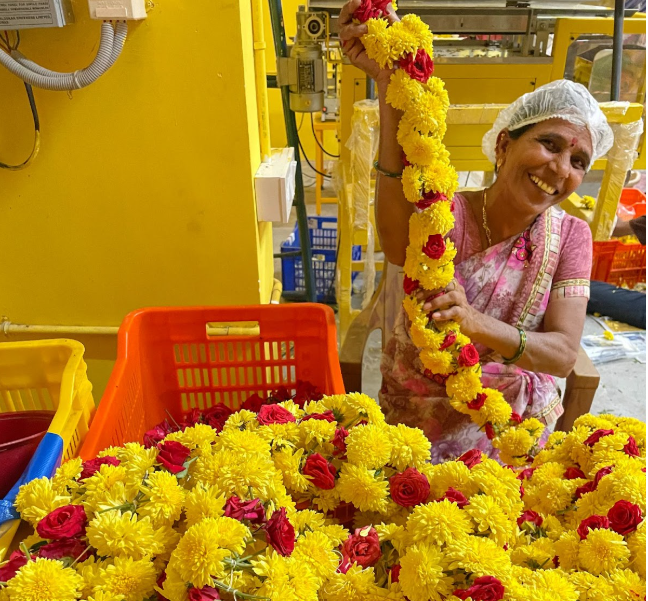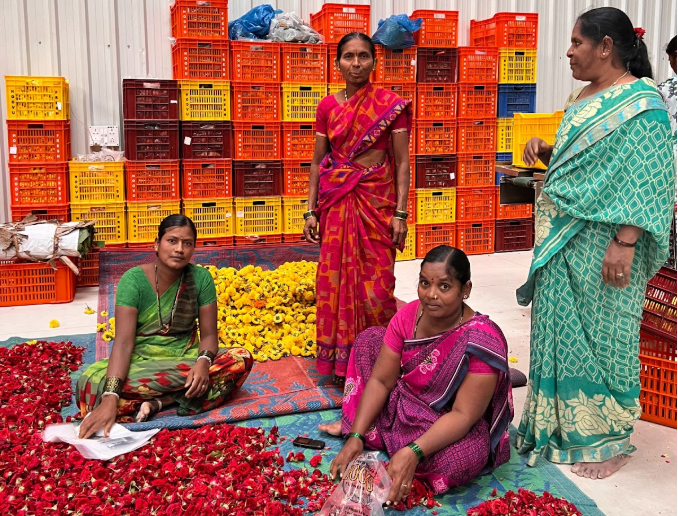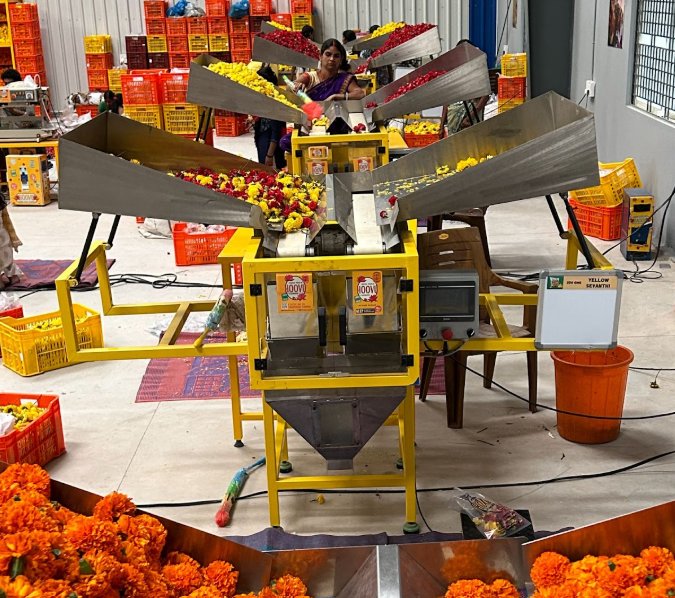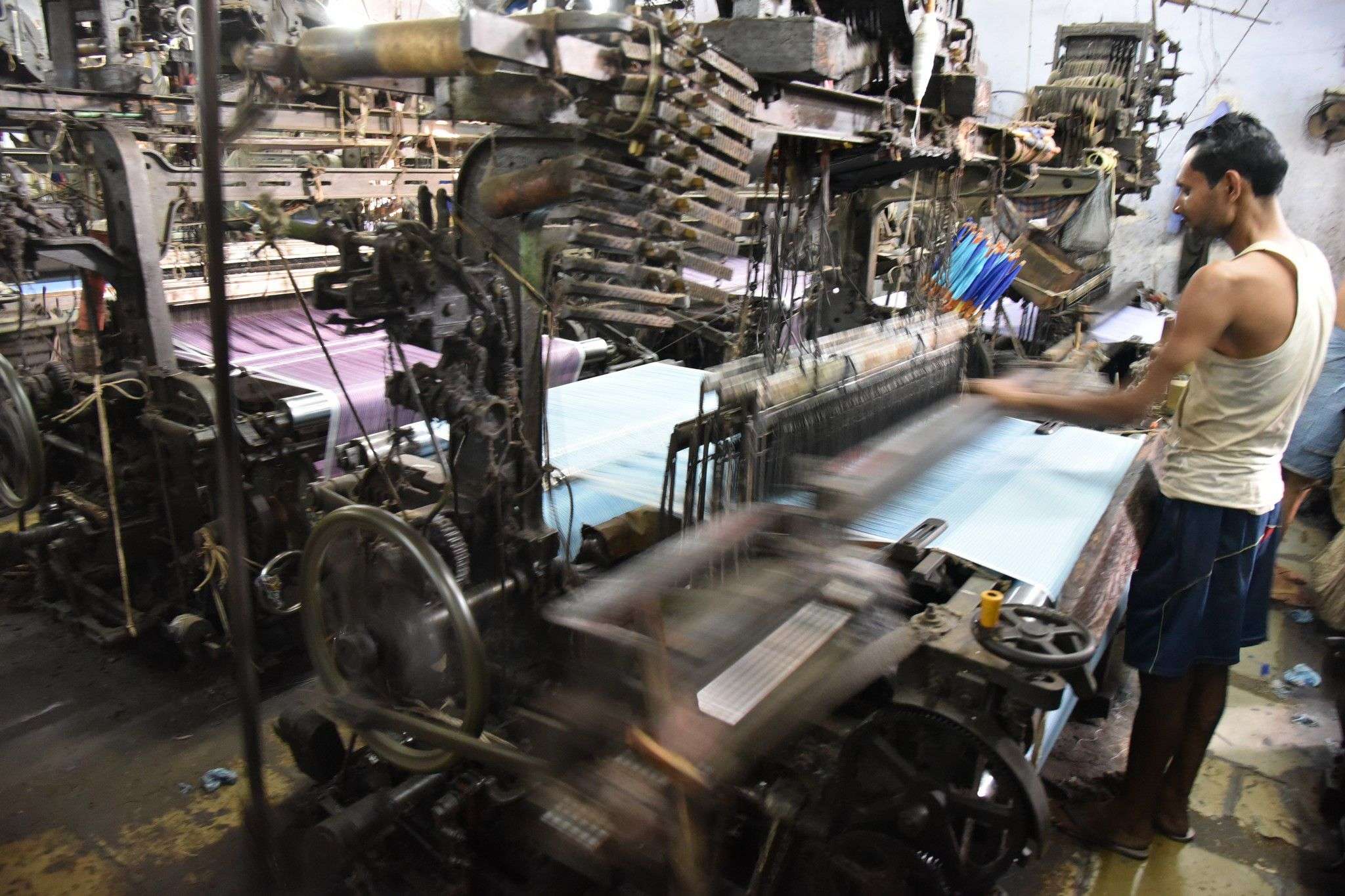Transforming India’s traditional flower market

Leveraging a legacy in floriculture, Rhea Karuturi (and her sister Yeshoda) co-founded Hoovu Fresh to streamline the fragmented puja flower market, enhancing freshness and reducing waste.
Growing up amidst the vibrant hues and scents of rose farms, sisters Yeshoda and Rhea Karuturi were immersed in the world of flowers from an early age. This upbringing provided the sisters with a unique perspective on the floral industry, witnessing its evolution from fragmented markets to more organized systems. While working within their family’s cut flower business, the Karuturi sisters identified a significant gap in the market. Despite the scalability and organization in the bouquet flower sector, they observed that the traditional flower market—encompassing staples like jasmine, marigold, chrysanthemum, and bud roses—remained largely unorganized. These flowers play an integral role in daily Indian life, used in morning prayers, personal adornment, and various forms of decoration. Yet, the supply chain for these blooms was riddled with inefficiencies, leading to up to 40% wastage—translating to approximately 22,800 acres of flowers discarded annually.

Motivated by this insight and leveraging their agricultural expertise, Yeshoda and Rhea co-founded Hoovu Fresh in 2019. Their mission: to revolutionize the traditional flower market by reducing the turnaround time from harvest to consumer to 12-24 hours and employing innovative packaging to extend shelf life by two to five times. Through these efforts, Hoovu Fresh aims to add value for both farmers and end customers, bringing much-needed efficiency to a longstanding industry.
In this interview, we delve into Rhea’s journey, exploring how her background and experiences have shaped her approach to transforming India’s traditional flower market.

Surya HK (SHK): Hoovu Fresh has grown significantly since its launch, expanding to multiple cities and platforms. What have been the biggest operational challenges in scaling a fresh flower business across India?
Rhea Karuturi (RK): Building a farmer network in new cities has been both our biggest challenge and opportunity. Regional variations in locally grown and used flowers mean each geography brings unique conditions. However, these learnings also help us expand our offerings in existing markets. Like any perishable business, we face logistical challenges, seasonality, and temperature fluctuations. But with improving market connectivity for farmers, solutions are emerging from all directions, making this an exciting time to grow.

RK: We’ve been obsessed with using technology to monitor our supply chain from day one, making it a core part of our company culture. Tracking flowers at every stage helps us intervene when needed to maintain freshness and reduce waste. It has also enabled us to build a unique database on price, quality, and demand, improving our planning and processing each year. Our biggest learning has been fostering a team that prioritizes freshness—from the garland makers to the data analysts. Our backbone is the hands on the ground, and we’ve structured our organization to best support our warehouse teams.

SHK: Hoovu Fresh is now a well-known name in the puja flower market. How has customer behavior evolved over the years, and what trends are shaping your business today?
RK: It’s always surreal to hear that we’ve gone from being complete unknowns to being “well known” in the puja market. Just a few years ago, people questioned whether puja flowers were a dying industry and assumed we were building a small lifestyle business with no real potential to scale. Today, the narrative has completely changed—customers now expect puja flowers delivered to their doorstep, and with each festival, their expectations grow, from staple flowers to nostalgic offerings from their childhood traditions. When we started, convincing platforms to bet on flowers as a category was an uphill battle. Now, every major quick commerce (QComm) and grocery platform has a puja flowers section, and during festivals, their CEOs proudly share sales numbers. There’s immense enthusiasm from our partners, and as customers grow more comfortable trusting us and QComm apps with their puja experience, this category will only expand. Initially, our biggest challenge was simply making people realize that puja flowers could be bought online—there was almost no search traffic because no one expected it. Today, that landscape has completely shifted. Customers now not only know they can get puja flowers online but also seek more novelty, looking to us to enhance their complete puja experience.

SHK: India has a highly fragmented and localized flower market. Have you faced resistance from traditional players or challenges in working with local farmers as you scale?
RK: We’ve been fortunate to work with many farmers who have welcomed us with enthusiasm. Market connectivity has long been a challenge for Indian farmers, especially in the puja flower industry, where flowers were traditionally sold only in mandis. The idea is simple: if this space grows, everyone benefits. There’s a strong incentive to collaborate and expand together. Since the online and modern trade markets for puja flowers are still in their early stages, the model for working together is still evolving—which makes it even more exciting to shape. Now, there’s even talk of setting up auction spaces for puja flowers, similar to cut flowers, which is incredible to see. When we started, that was our moonshot idea.
SHK: With more delivery platforms and quick commerce players expanding into the fresh flower category, how do you see competition evolving?
RK: Definitely! We saw it right after Shark Tank too. We were lucky to start in a completely new space with no real competitors, but we always knew that would change. If no one’s trying to copy you, you’re probably not doing too well, right? So it’s actually a positive sign that so many people see this opportunity as exciting and scalable. Luckily, we’ve been paranoid from day one—constantly thinking about what’s next and how to improve—so we’re never caught resting on our laurels. More broadly, Yeshoda and I always wanted this product to win because we truly believed in it. It’s amazing to see a Hoovu flower packet in a customer’s home or on a supermarket shelf. But even when I open a q-commerce app during a festival and see flowers featured at the top—even if they don’t carry the Hoovu name—I know that’s us. That’s our team, our belief in this product, and our hard work paying off. And that’s incredibly rewarding and humbling.
SHK: Given the shift toward sustainable and eco-friendly consumer choices, how are you incorporating sustainability into your products and processes?
RK: Reducing wastage has always been at the heart of our processes, and we continue to innovate on that by using flowers – including the ones that can’t be used for puja – in new ways. Whether that’s making our agarbathis, our holi colors, potpourri for our orders etc – we’re always looking at what more we can do.
SHK: Hoovu Fresh has successfully built a brand in a highly traditional industry. What’s next—new geographies, global expansion, or a deeper push into the Indian market?
RK: Our plan for this year is to expand to more cities within India and expand our offerings within the puja space. We’re working on a fresh take on the “daily puja package” concept which we still feel nobody has fully cracked. Since we’re coming to your doorstep everyday with our fresh flower offerings, we want to bring with us the rest of your puja needs too – from agarbathis to camphor and kumkum. So many of these products have been consumed in the same format for decades now and we think a dose of freshness will make the puja experience all the more special – and nobody is as obsessed with freshness as us.
Disclaimer
Views expressed above are the author’s own.
END OF ARTICLE





